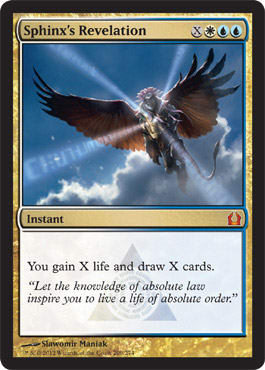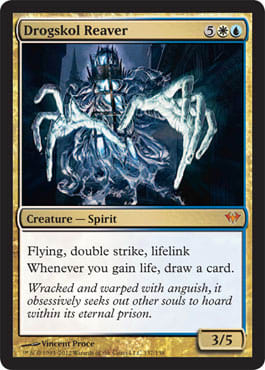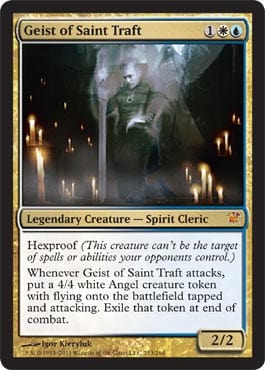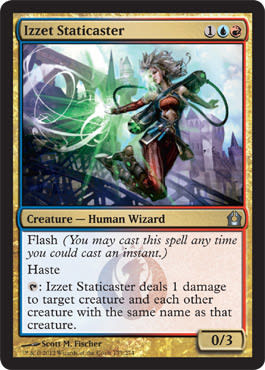I wanted to do something different last weekend, but I ended up just playing Bant again. You see, I play a weekly Standard tournament at Get Your Game on most Sundays, and it’s full of aggressive decks. I said it wasn’t wise to play Bant, as it has trouble with all of the haste creatures in the format, but I have more fun playing with Sphinx's Revelation than any other card.
Here’s the list I played:
"Standard Bant"
- Creatures (10)
- 1 Drogskol Reaver
- 2 Restoration Angel
- 2 Snapcaster Mage
- 4 Thragtusk
- 1 Sigarda, Host of Herons
- Planeswalkers (4)
- 2 Jace, Architect of Thought
- 2 Tamiyo, the Moon Sage
- Spells (21)
- 3 Dissipate
- 3 Sphinx's Revelation
- 4 Azorius Charm
- 4 Farseek
- 4 Supreme Verdict
- 3 Detention Sphere
- Lands (25)
- 1 Plains
- 2 Island
- 2 Alchemist's Refuge
- 4 Glacial Fortress
- 4 Hallowed Fountain
- 4 Hinterland Harbor
- 4 Sunpetal Grove
- 4 Temple Garden
- Sideboard (15)
- 2 Rest in Peace
- 2 Centaur Healer
- 2 Rhox Faithmender
- 3 Terminus
- 2 Negate
- 1 Dispel
- 1 Clone
- 1 Jace, Memory Adept
- 1 Selesnya Charm
I’m sure there’s a guy/girl at your store who will play a certain archetype no matter what because he or she wants to have fun. Sphinx's Revelation has brought that out in me, as it can be quite fun to cast a powerful blue spell.
For a few reasons, this deck does not play out the same way as the traditional Bant deck popularized by Reid Duke:
- Everyone has Sphinx's Revelation on his radar and comes equipped with Slaughter Games. I don’t want to be a one-trick pony, so I chose to diversify threats.
- I want to be more proactive because casting Think Twice in the early game is not my idea of a good time against Zombies.
- When R/W/U Flash decks play cards like Counterflux, your Elixir of Immortality isn’t safe anymore.
- Augur of Bolas means I have to play fewer Detention Spheres, but I have been sad whenever I cut down to two. It’s so much better than Oblivion Ring in control decks.
The main change to this deck is that I cut the Cavern of Souls for a pair of Alchemist's Refuge. Why would I do such a thing?
- An instant-speed Supreme Verdict is very strong against aggro because you can play it on the player’s end step. This allows you to enjoy an untap step before the aggro player starts unloading all of the creatures he kept in hand to avoid overextending.
- Cavern of Souls is becoming less impressive, as the Flash decks rely on creature kill over counters to stop large, uncounterable threats such as Hellrider and Thundermaw Hellkite out of Zombies. A good example of this is Gerry Thompson’s deck from Grand Prix: San Antonio or the TCGplayer invitational since he cut down to four counters for Pillar of Flames.
- Alchemist's Refuge is still strong against Flash decks because instants have historically been a good way to fight countermagic.
- The fundamental issue with Bant is addressed by playing an extra copy of Refuge because you can play sorcery-speed removal to stop the popular haste creatures such as Thundermaw Hellkite, Hellrider, and Falkenrath Aristocrat.
- It’s important to not go overboard on colorless lands, and I think this is currently the most important one to play. Once I have three colorless lands in my deck, the draws become increasingly more awkward.
- The other Bant decks rely on winning with just Thragtusk. This means they only need one Cavern to have all of their threats resolve. The same can’t be said for this deck, as you have Spirits, Beasts, and Angels (oh my!).
Some minor changes to my previous versions of this deck include cutting down to two copies of Jace, Architect of Thought for an extra Restoration Angel. I did this because she fights planeswalkers, can be cast at instant speed, and combos with Drogskol Reaver. Snapcaster Mage also becomes more powerful with the extra Angel; I can blink it for 6 mana and recast Azorius Charm.
It’s also important to note I can deck because I don’t play Elixir of Immortality. As I was wrapping up games with Sphinx's Revelation, I needed more ways to close, and Jace didn’t help this issue. Tamiyo, the Moon Sage can save you from this problem because once you have an emblem, you can attack with Thragtusk and continually put it back in your hand.
I play so many Detention Spheres and Supreme Verdicts because they’re the best spells to abuse Alchemist's Refuge. It can be tempting to avoid this mess and splash black for Ultimate Price or another instant-speed kill spell, but this has been strong so far. I also feel safe playing plenty of Supreme Verdicts, as they kill Geist of Saint Traft, which has been gaining in popularity.
Things to keep in mind with Drogskol Reaver:
- It doesn’t die to Selesnya Charm or Ultimate Price, but it still dies to other popular removal such as Sever the Bloodline, Victim of Night, Supreme Verdict, Terminus, and Oblivion Ring/Detention Sphere.
- It might be wise to flash it in with Alchemist's Refuge for 10 mana since nearly all removal for it is sorcery-speed.
- When you cast Thragtusk, Centaur Healer, or Sphinx's Revelation for 1 or greater, you draw a card.
- Blinking it out with Restoration Angel can lead to blowouts such as it attacking and blocking in the same turn (thus drawing you up to 4 cards total).
- You must draw a card when you gain life. Watch out that you don’t deck yourself!
- The fact that you block doesn’t necessarily mean you gained 6 life. If the opposing creature has less than 4 toughness, it dies before regular damage. This means you gain 3 life and draw one card. I like to be aggressive with Reaver because it’s a stronger attacker.
I ended up splitting the Top 4 for $85 store credit, defeating Red Deck Wins, Jund, and B/G aggro along the way. There was also an unintentional draw against R/W/U Flash because we had five minutes left going into Game 3. I was very happy the way the deck played out, and I wouldn’t be opposed to playing it again in the future. My major change to the deck is to cut the Sigarda, Host of Herons, as it was quite awkward against Thundermaw Hellkite.
American Aggro
I tried some other decks to see how they would fare before the tournament. Since Geist of Saint Traft had such a good weekend at the TCGplayer MaxPoints Invitational, I decided to give it my own spin:
"American Aggro"
- Creatures (15)
- 3 Thundermaw Hellkite
- 4 Restoration Angel
- 4 Snapcaster Mage
- 4 Geist of Saint Traft
- Spells (20)
- 1 Dissipate
- 1 Unsummon
- 3 Azorius Charm
- 3 Searing Spear
- 3 Sphinx's Revelation
- 4 Thought Scour
- 1 Mizzium Mortars
- 2 Pillar of Flame
- 1 Detention Sphere
- 1 Runechanter's Pike
- Lands (25)
- 1 Island
- 1 Mountain
- 1 Plains
- 2 Cavern of Souls
- 4 Clifftop Retreat
- 4 Glacial Fortress
- 4 Hallowed Fountain
- 4 Steam Vents
- 4 Sulfur Falls
Casting Geist of Saint Traft is usually something that’s right up my alley, but I just didn’t like the overall feel of the American Aggro deck. I don’t think racing with Geist is where you want to be at this point since beating G/W aggro is a tall order.
Many of the traditional American Aggro decks I saw online—such as Ryan Hipp’s winning list from the TCGplayer invitational—played twenty-four lands with four colorless sources. This felt wrong to me, as I was losing to myself while goldfishing far too often. What’s the point of Moorland Haunt if these decks now play a maximum of one Runechanter's Pike? Cavern of Souls works better in this deck because the creatures are more difficult to cast in the early game.
A trick with Cavern of Souls is to name a creature type against blue that’s likely to be Azorius Charmed. Even if you resolved your Thundermaw Hellkite, you’re not out of the woods yet, as it may be sent to the top of your deck. It may seem silly to name Human in the midgame, but I sometimes needed the extra blue source for Snapcaster Mage in order to flash back a Dissipate.
The main takeaway from this particular list is that the power of Sphinx's Revelation can be felt even in semi-aggressive Geist decks. Since you only have seven real creatures to close a game (Geist and Dragon), your draw may be slower than you want. The Revelations were very impressive, as they can be chained in the late game with Snapcaster Mage. Twenty-five mana sources were enough to draw plenty of cards because you also have Thought Scour to make land drops.
This deck is not designed to play out as a Sphinx's Revelation control deck, but I felt it was necessary to begin with twenty-five lands. It seems incredibly greedy to play twenty-four lands and want to hit your first five lands every game for Thundermaw Hellkite.
I cut down on counters because Syncopate isn’t very strong and the rest interfere with Geist of Saint Traft. When I can start casting Dissipate, it’s ideally time to play Geist. Cavern of Souls is still a popular card, too.
The large number of singletons were added because Sphinx's Revelation and Thought Scour let me see more of my deck. You can mill random spells and flash them back with Snapcaster Mage later in the game. I like exactly one Runechanter's Pike because it’s a strong late-game threat, but I don’t want it in my opening hand. It’s a card you can draw with Sphinx's Revelation and win the following turn. Mizzium Mortars also plays a similar role: Cast it in the late game, and swing for the win. It’s also important to fight Loxodon Smiter in the early game.
I’m not saying you should play this exact list, but rather try out some of the theories behind this deck. This deck recently spiked thanks to the resurgence of Zombies, but it will become weaker as the other decks begin to hate out Geist.
Standard Review
I want to wrap up this article by going over some of the more interesting card choices from Grand Prix: Nagoya and SCG Open: Las Vegas. It seems that the Japanese love to play cool cards that often go unnoticed.
This deck won a Grand Prix with four Chronic Flooding!
"Chronic Glory"
- Creatures (18)
- 1 Goldnight Commander
- 1 Zealous Conscripts
- 4 Angel of Glory's Rise
- 4 Huntmaster of the Fells
- 4 Izzet Staticaster
- 4 Nightshade Peddler
- Spells (19)
- 2 Izzet Charm
- 1 Tracker's Instincts
- 4 Faithless Looting
- 4 Mulch
- 4 Unburial Rites
- 4 Chronic Flooding
- Lands (23)
- 1 Clifftop Retreat
- 1 Sulfur Falls
- 1 Sunpetal Grove
- 2 Hallowed Fountain
- 2 Hinterland Harbor
- 4 Cavern of Souls
- 4 Rootbound Crag
- 4 Steam Vents
- 4 Temple Garden
- Sideboard (15)
- 2 Zealous Conscripts
- 2 Goldnight Commander
- 4 Cathedral Sanctifier
- 2 Rolling Temblor
- 2 Izzet Charm
- 2 Ray of Revelation
- 1 Geist-Honored Monk
Quick notes:
- This deck mills Humans into the graveyard and brings them all back with Angel of Glory's Rise. In the process, it also kills opposing Zombies, which happen to be popular (coincidence?).
- Luckily for Okita, Izzet Staticaster and Nightshade Peddler happen to be Humans and make a great pair.
- Expect more Nightshade Peddlers in the future; this combo is powerful and fun!
- There are so many possibilities with Unburial Rites, and it all depends on the metagame. Like Craterhoof Behemoth, it’s probably best to avoid this deck, as the masses will now be ready.
Naya took down yet another SCG Open tournament, but it also made Top 8 in Nagoya.
"Standard Naya"
- Creatures (24)
- 4 Avacyn's Pilgrim
- 4 Huntmaster of the Fells
- 4 Loxodon Smiter
- 4 Restoration Angel
- 4 Thragtusk
- 4 Thundermaw Hellkite
- Spells (12)
- 4 Selesnya Charm
- 4 Bonfire of the Damned
- 4 Farseek
- Lands (24)
- 3 Mountain
- 4 Forest
- 2 Kessig Wolf Run
- 3 Clifftop Retreat
- 4 Cavern of Souls
- 4 Rootbound Crag
- 4 Temple Garden
- Sideboard (15)
- 2 Angel of Serenity
- 2 Rest in Peace
- 2 Garruk Relentless
- 2 Garruk, Primal Hunter
- 4 Pillar of Flame
- 2 Sigarda, Host of Herons
- 1 Ray of Revelation
Thundermaw Hellkite is here to stay in midrange, as it has also been incorporated into Jund decks.
Matsumoto Yuki simply added green to his R/W/U midrange deck and took ninth in Nagoya. I like his style, as it plays some of my favorite cards:
"Nonblack Midrange"
- Creatures (13)
- 2 Snapcaster Mage
- 3 Restoration Angel
- 4 Huntmaster of the Fells
- 4 Thragtusk
- Spells (21)
- 2 Sphinx's Revelation
- 3 Izzet Charm
- 3 Syncopate
- 3 Think Twice
- 4 Searing Spear
- 3 Mizzium Mortars
- 3 Detention Sphere
- Lands (26)
- 2 Cavern of Souls
- 2 Clifftop Retreat
- 3 Glacial Fortress
- 3 Rootbound Crag
- 4 Hallowed Fountain
- 4 Steam Vents
- 4 Sulfur Falls
- 4 Temple Garden
- Sideboard (15)
- 4 Geist of Saint Traft
- 2 Thundermaw Hellkite
- 2 Rhox Faithmender
- 1 Zealous Conscripts
- 3 Pillar of Flame
- 1 Dissipate
- 1 Ray of Revelation
- 1 Purify the Grave
- I think this deck needs some Izzet Staticasters in the sideboard (and possibly Nightshade Peddlers!).
- I was very impressed by Rhox Faithmender in Bant, as it’s a great way to run away with the game against aggro.
Jeff Lavine took sixth at the SCG Open in Las Vegas with this spicy number:
"Four-Color Staticaster"
- Creatures (23)
- 2 Borderland Ranger
- 2 Nightshade Peddler
- 2 Snapcaster Mage
- 2 Thundermaw Hellkite
- 3 Izzet Staticaster
- 4 Huntmaster of the Fells
- 4 Restoration Angel
- 4 Thragtusk
- Spells (13)
- 1 Counterflux
- 2 Searing Spear
- 2 Bonfire of the Damned
- 4 Farseek
- 4 Pillar of Flame
- Lands (24)
- 1 Forest
- 1 Island
- 2 Mountain
- 1 Kessig Wolf Run
- 1 Sulfur Falls
- 2 Hallowed Fountain
- 2 Temple Garden
- 3 Cavern of Souls
- 3 Hinterland Harbor
- 4 Rootbound Crag
- 4 Steam Vents
- Sideboard (15)
- 2 Dungeon Geists
- 1 Nightshade Peddler
- 3 Rest in Peace
- 1 Counterflux
- 2 Izzet Charm
- 1 Negate
- 2 Searing Spear
- 2 Syncopate
- 1 Bonfire of the Damned
- Nightshade Peddler has great synergy with Restoration Angel because you can reset the deathtouch pairing as an instant.
- Huntmaster of the Fells can transform with deathtouch to kill any creature.
- Kessig Wolf Run combined with a deathtouch pairing means you need to deal the blocker only 1 damage and the rest to the opponent’s face.Thundermaw Hellkite plus Peddler kill all of your opponent’s flyers.
- I would love to see a couple Sphinx's Revelations in here.
- The power of Nightshade Peddler will go down as more people play it because it dies to Izzet Staticaster.
- Many of the creatures in this deck happen to be Humans, which makes Cavern of Souls less awkward. I like this because you should play at least one Kessig Wolf Run.
What’s that? You want to play Sphinx's Revelation in Naya? Try out the second-place deck by Jun Yu at SCG: Vegas:
"Revelation Naya"
- Creatures (19)
- 2 Centaur Healer
- 2 Thundermaw Hellkite
- 3 Borderland Ranger
- 4 Huntmaster of the Fells
- 4 Restoration Angel
- 4 Thragtusk
- Planeswalkers (1)
- 1 Garruk, Primal Hunter
- Spells (16)
- 2 Sphinx's Revelation
- 3 Selesnya Charm
- 4 Searing Spear
- 3 Bonfire of the Damned
- 4 Farseek
- Lands (24)
- 1 Island
- 1 Mountain
- 1 Plains
- 2 Forest
- 1 Gavony Township
- 1 Hallowed Fountain
- 1 Overgrown Tomb
- 1 Sunpetal Grove
- 2 Clifftop Retreat
- 2 Kessig Wolf Run
- 3 Steam Vents
- 4 Rootbound Crag
- 4 Temple Garden
- Sideboard (15)
- 1 Acidic Slime ">Acidic Slime
- 3 Deathrite Shaman ">Deathrite Shaman
- 2 Zealous Conscripts
- 1 Curse of Echoes
- 1 Detention Sphere
- 1 Oblivion Ring
- 1 Rest in Peace
- 1 Ray of Revelation
- 1 Selesnya Charm
- 2 Sigarda, Host of Herons
- 1 Jace, Memory Adept
Acidic Slime |3 Deathrite Shaman |2 Zealous Conscripts |1 Curse of Echoes |1 Detention Sphere |1 Oblivion Ring |1 Rest in Peace |1 Ray of Revelation |1 Selesnya Charm |2 Sigarda, Host of Herons |1 Jace, Memory Adept ">
Quick Notes:
- Borderland Ranger looks like a card you can immediately cut, but it appears to be crucial for actually casting Sphinx's Revelation.
- I’m going to experiment with a Staticaster/Peddler shell that looks something like this.
- I can’t wait to play this deck because it looks so fun (I’m not even kidding).
Quick notes about the format as a whole:
- The powerhouses in midrange can be configured in such a way to play the cards you enjoy the most. I love Sphinx's Revelation and don’t have to leave them at home just because Naya looks good.
- There were seven Zombie decks in the Top 16 of Nagoya despite all of the awesome decks I showcased earlier. I also saw a few Red Deck Wins splashing Falkenrath Aristocrat.
- Nightshade Peddler is awesome because it works so well with Izzet Staticaster (and they’re both Humans for Cavern of Souls).
- Geist of Saint Traft had a bad showing in Nagoya and Vegas (two of thirty-two decks played it main-decked). Perhaps main-decking Izzet Staticaster is the way of the future for them. I also saw a deck at the SCG Open that played Silverblade Paladin for Thundermaw Hellkite.
- Bant is still capable of winning, but only if you believe in the heart of the cards.
Playing a deck simply because it does well is a fool’s game. You will win much more if you have fun casting your spells!
Thanks for reading and have fun!
-Kyle
kmboggemesATgmailDOTcom




























